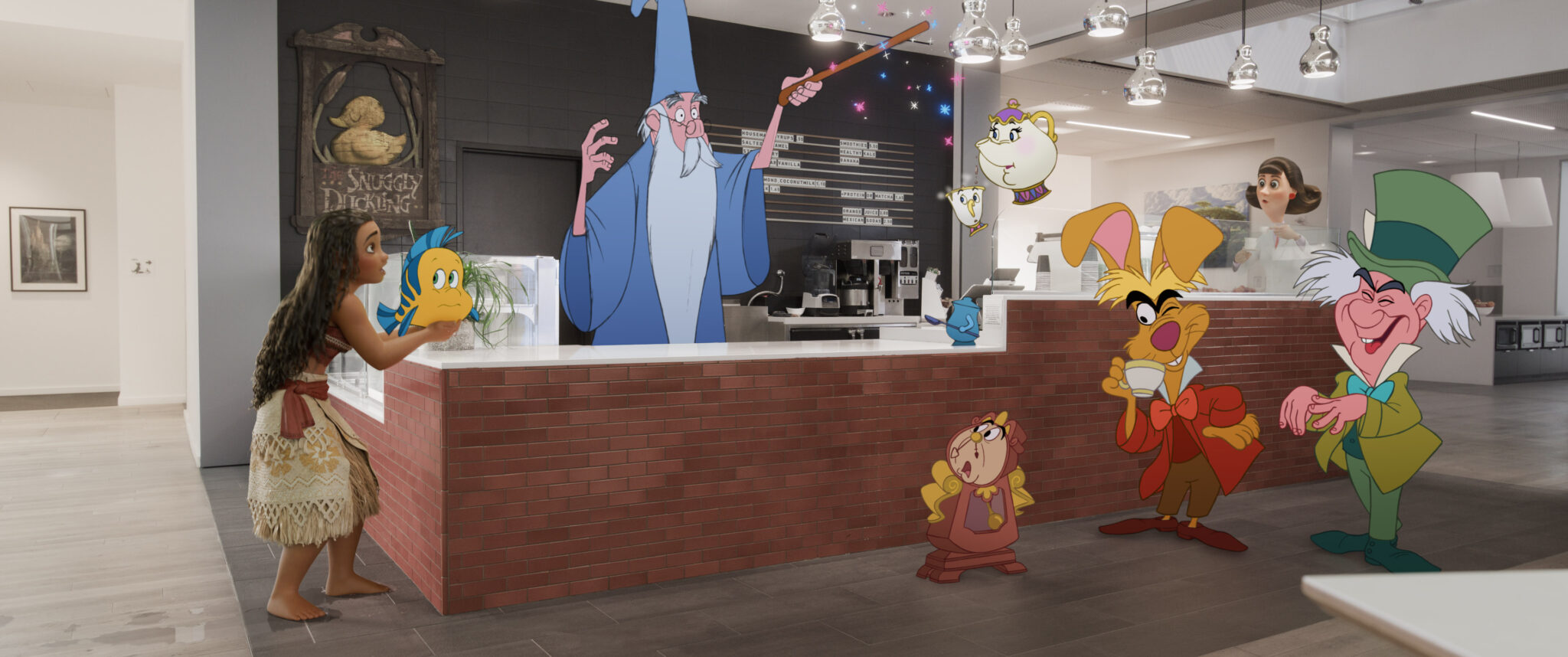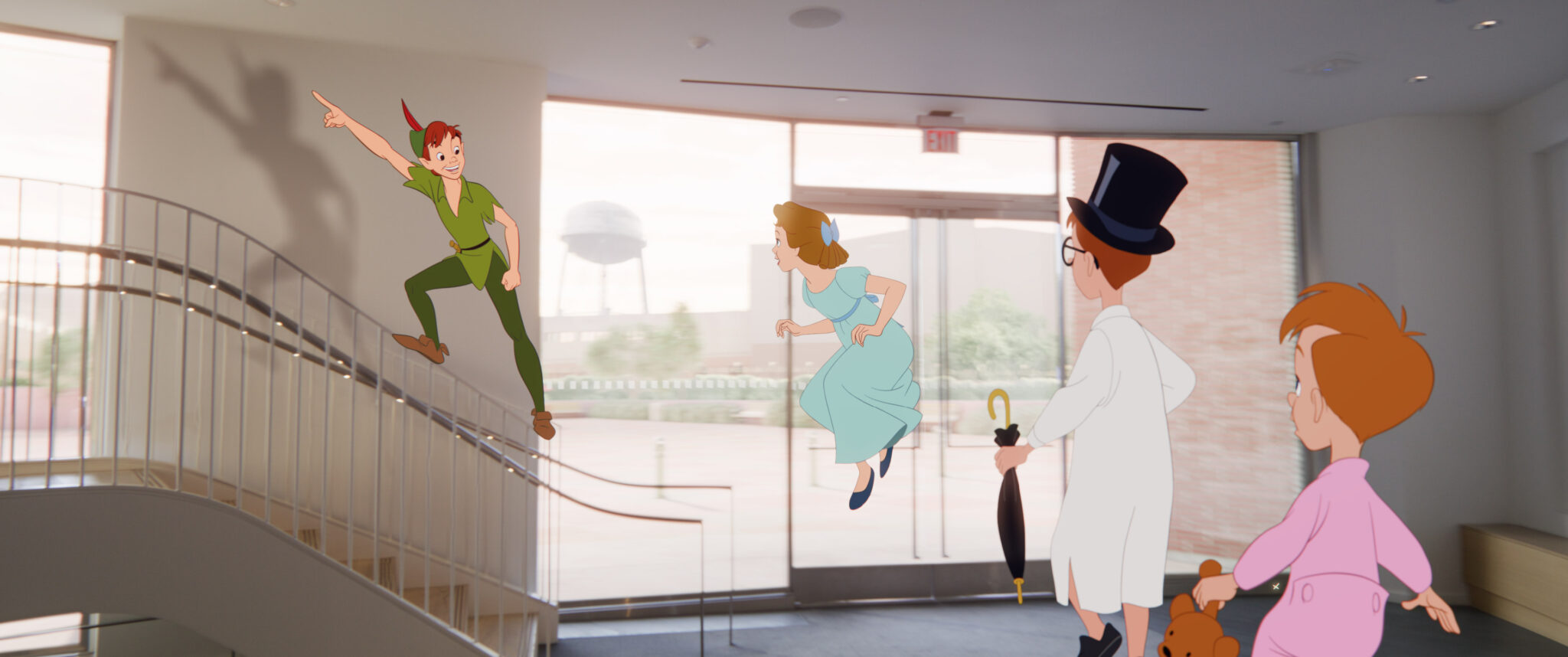For your reading pleasure, please enjoy our interview with Dan Abraham & Trent Correy about writing and directing Disney Animation’s Once Upon a Studio. We hope you’ll join us to read the rest of the issue by subscribing to Backstory Magazine!
Directors Dan Abraham and Trent Correy on crafting their touching tribute to the artists and characters from Disney Animation’s first century.
By Danny Munso
Once Upon a Studio—Walt Disney Animation’s new short film that celebrates the immense legacy of the company’s first 100 years—is many things. It’s a touching tribute to the artists, both past and present, that made Disney Animation what it is today. It’s a creative excuse to gather more than 500 animated characters into one 10-minute film that alternates between hilarious and heartwarming. It’s also quite possibly the first Disney Animation project that was at least partially conceived in a Taco Bell parking lot.
The film is the brainchild of Disney Animation stalwarts Dan Abraham and Trent Correy, who teamed up to helm 2020’s Frozen short Once Upon a Snowman and wanted to find another way to work together even as they began working on separate projects for the studio: Abraham on Baymax! and Correy on Zootopia+. This was 2021 and the entire studio was working remotely because of COVID and the pair began communicating about what their next collaboration could be. “We left that experience saying we want to work together again because it was so much fun,” Correy recalls. “We quickly realized the 100-year anniversary was just two years out.” The germ of an idea began to form quickly. “There wasn’t really anything in the works that celebrated the legacy characters,” Abraham says. “We wanted to see something like that so we said how cool would it be to get all of the characters together in the same place? That led to why would they be together? So we started spit-balling ideas back and forth.”
The two began discussing the studio itself and how when they were younger and watching behind the scenes content set in the Animation Building, they would be fascinated with what was in the hallways or what each animator had on their desk. “That seemed like a good idea so we said why don’t we place it in the studio?” Abraham remembers. “Then Trent came up with the great idea of having the characters come to life from the artwork on the walls. We came up with the idea all of the characters were gathering for a group photo outside the building because that’s what we do at the studio every year.” At first, the pair started sending drawings of possible moments to one another back and forth and Correy recalls when Abraham sent him a sketch of Christopher Robin and the other characters from the Hundred Acre Wood trying to pull a stuck Winnie-the-Pooh from a picture frame, that set the template for the work going forward. “That was probably the first drawing that was this project in a nutshell,” Correy says. “It just started picking up momentum from there.”

There was just one issue at this time. Not only had the project not been greenlit by the studio, but no one—except Abraham, Correy and their partners—even knew about it. The pair worked on the short for 8 months in complete secrecy, mostly on off hours and weekends. And yes, sometimes in the parking lots of fast-food restaurants. “Dan would come to my backyard, we did Zoom chats, we had Taco Bell parking lot conversations,” Correy laughs. “We would show up in separate cars and go through the drive thru, park, and roll down our windows and have conversations back and forth.” After that eight-month period, they called up Disney Animation’s Chief Creative Officer Jennifer Lee and told her they had something to pitch her. “She was confused but she said ok,” Abraham recalls. “This was still over Zoom because of COVID so I tapped through all of the storyboards.” Lee’s reaction was more than positive, it was full of emotion. “She said I don’t know how but we have to figure out how to make this,” Abraham continues. “In that pitch we had over 500 characters in it. We talked about wanting to have our hand-drawn character done on paper, plus our CG characters, plus the live-action plates that would be our studio. We knew we were swinging for the fences with it and we assumed the answer would be no because there was a lot to figure out. So much of it is about timing. We didn’t know if we had the manpower here at the studio to actually take on something like this. We didn’t know if there were other projects in the works about to be greenlit. We just went in blind. We just made what we would want to see as Disney fans and she said yes.”
Thanks to the 8-month private story process, the version they pitched to Lee is remarkably close to the finished film. The pitch—like the finished film—began with a group of Disney Animation employees leaving the building at the end of the day. The last two to shut the doors are a young intern and Disney legend Bernie Mattinson (much more on him soon). Mattinson looks back at the building and proclaims, “if these walls could talk,” before closing the door. The camera then pans to an animation cell of Mickey and Minnie from the 1942 short Mickey’s Birthday Party. The pair spring to life, hop out of the frame and begin to gather hundreds of characters throughout the building in an attempt to take a group photo outside. The short crescendos with multiple characters taking turns singing “When You Wish Upon a Star.” “It’s actually sort of remarkable how similar (the final film) is to the pitch,” Abraham says. “We thought there would be mandates of you have to make sure this character is in there or you can’t show this character doing this. But they really left us alone. We did get notes but they sort of let us pick which notes we took that best supported our idea. They really trusted us. We know these characters and we had such an honor to represent them. It was all coming from a sincere place.”
In terms of populating the short with characters and giving certain ones their own spotlight moment, the filmmakers liken it to piecing together a puzzle. “We set out with the goal to represent the 62 feature films and as many shorts as we could in between,” Correy says. “Dan and I were left to fill the screen with the characters we wanted. So we were just in the story room trying to make each other laugh, swapping out characters, trying to find a balance of 2D and 3D characters, newer characters, legacy characters. It was fun to put together.” Every major Disney character is represented—from Goofy to Aladdin to Anna & Elsa and everyone in between. But the short is also populated with more obscure characters, some from their lesser-known theatrical releases as well as the studio’s vaunted back catalog of short films, like Susie the Little Blue Coup or Lambert the Sheepish Lion (a personal fave of this writer), two stars of their own short films from the 50’s. Including some of these smaller characters meant that some of the more popular ones wouldn’t get as much screentime as expected. “I’m such a huge Disney nerd and fan that I have this Disney rolodex in my head,” Abraham says. “I couldn’t draw fast enough all these different ideas. It’s 100 years of characters so it’s a treasure trove. What we realized was every second you’re with one character, it’s actually taking time away from other characters. We still see Ariel and Stitch and you still have those characters around. But there’s someone out there that loves Chicken Little (from the 2005 film) or they love Johnny Appleseed (from the 1948 feature Melody Time) or they love Johnny Fedora and Alice Bluebonnet (from the 1946 film Make Mine Music and later its own short) and they never get to see those characters. So we really did our best to get some of the more obscure ones in there.”

L-R: Dan Abraham, Trent Correy
A bonus of including some of these other characters is the chance to allow newer viewers to find out more about them, something the filmmakers have already discovered is happening. In one of the short’s best scenes, an increasingly-agitated Donald Duck is holding the elevator for Zootopia’s notoriously slow sloth Flash. In the elevator with Donald are Humphrey the Bear and J. Audubon Woodlore, the ranger that looks after the park Humphrey inhabits, co-stars of a handful of shorts from the 50’s. Though Humphrey has had his own select merchandise over the years and he is featured in a resort at Walt Disney World, the directors found out he may not be the household name they assumed. “I was reading on the Internet that there are a lot of people that don’t know who Humphrey is,” Abraham remarks. “I was really surprised by that. Hopefully it will make everyone wonder who that is and then they can go find and watch those great cartoons.”
An element of the short the directors thought would surely be the subject of great debate at the studio is which version of Mickey Mouse should appear in the film. From the character’s early black and white debut to his most recent 2D iteration that first appeared in 2013, there are countless Mickey’s to choose from. From the start, Abraham and Correy wanted the 1940’s Mickey and the reason was 100% story-based and tied to the most poignant section of the film that sees Mickey, while walking through the hallways of the Animation Building to gather characters, approaches a portrait of Walt Disney, removes his hat in reverence and says, “thanks.” The moment is punctuated with a brief piano version of the Mary Poppins song “Feed the Birds,” penned by Walt’s longtime songwriters Robert and Richard Sherman. “It came because we knew we wanted a Walt and Mickey moment,” Abraham says. “We came up with the idea of Mickey looking at Walt’s portrait and we wanted to pepper in ‘Feed the Birds,’ which the Sherman Brothers have referred to as Walt’s favorite song. All of those things were really feeling right and I thought oh, wouldn’t it be a really nice visual if Mickey took his hat off and put it on his heart as he’s looking at Walt? Then I thought, oh in Mickey’s Birthday Party, he’s got that really cute little yellow hat. That would be a nice casual, everyday Mickey to lead this whole thing. The whole thing just felt right.” Months after boarding that moment, Abraham and Correy found themselves in Walt Disney’s original office with Richard Sherman himself where the legendary songwriter played the version of “Feed the Birds” we hear in the short on the exact same piano where he and brother wrote the song almost 60 years before.
The same level of care and love the filmmakers and studio supplied for that moment was also extended to the appearance of Mattinson. To call Mattinson a legend of the studio is actually underselling his resume. He is the longest tenured employee of The Walt Disney Company in its century-long history, having started all the way back in 1954. He contributed as an animator, story artist, writer and director to too many Disney Animation projects to list here, including the studio’s most recent release, 2022’s Strange World, which featured a character named after Mattinson (Legend, the dog that Mattinson insisted to director Don Hall the film needed.) He was still working on a project with Hall up until his death in February of this year. The reverence the other employees of the studio have for Mattinson is best exemplified by the fact that he was in the very first storyboards Abraham and Correy did for this film back when the project was still their own secret. “My first boards were Bernie Mattinson and a young intern are walking out of the studio at the end of the day,” Abraham recalls. “Bernie was in the movie for months and months before he even knew he was in it. We were so happy when we told him about the project that he was really excited to be in it.” The film includes a dedication to Mattinson at the end and if everyone had their way, Mattinson would have been even moreinvolved. As a nod to Bernie, Abraham and Correy gave a brief scene to Scrooge from Mattison’s masterpiece Mickey’s Christmas Carol, which he wrote and directed in 1983. Lead animator Eric Goldberg—a Disney legend in his own right—asked Mattinson if he wanted to personally animate Scrooge for that scene, but he politely declined. Though the studio is still grieving for their loss, the directors are pleased Once Upon a Studio is perhaps giving Mattinson a whole new platform. “It’s been nice to see people giving him shoutouts and giving him the spotlight,” Correy says. “I like to think that people can watch the short and after the dedication at the end, maybe people are Googling him and learning about his career.”

Having so many characters in the film meant bringing back a lot of those actors to portray those characters once again, even if most of them only had one line. But the filmmakers also wanted to hear some of the older character voices as well from actors that have passed away. There has been a lot of publicity about the return of the late great Robin Williams to the voice of the Genie, which used an unused line from Williams during the recording of Aladdinwith his estate’s permission. But it was the return of another classic character that affected how the entire ending of the film would proceed. For the “When You Wish Upon a Star” finale, Abraham and Correy really wanted to find a way to use the voice of Cliff Edwards—the original performer of Jiminy Cricket—who first sang the song on screen in Pinocchio in 1940. “That was something we really wanted to happen,” Correy said. “The music team here found a way. There was no recording they could find of it where the singing was separated from the music track so the wizards here really worked hard to separate that track and take the music out of it.” They then worked backward from that. Since Edwards sang that song in a particular key, all of the other performers and the choir that accompanies them had to sing in the same key to match his vocal. “They had to build the whole song in that key,” Abraham says. “Because that’s the key Cliff was singing in and we were always going to use that for the end.”
Because of the care and attention put into it by its directors, Once Upon a Studio is one of the best short films in the entire history of Disney Animation. Abraham and Correy have worked on short-form projects—both separate and together—over the years at the company and they see the short as an important tool for the studio going forward as well. “If there was a job out there where Dan and I could make shorts together for the rest of our lives, I would happily do that because I think the medium is so cool,” Correy says. “But I like to think that the shorts here have always been a tradition of pushing technology and experimenting with things. From Flowers and Trees up to our recent Short Circuit program and everything in between. They’re a great way to test tools and a great way internally to try out new talent and give people opportunity and to teach people how to work with the pipeline. So I think they will always be around.”
Click here if you wish to read more about Bernie Mattinson’s incredible legacy.
If you’d like to subscribe, feel free to use coupon code: SAVE5 to take $5 off your subscription and get instant access!
All you need to do is click here to subscribe!
There’s plenty more to explore in Backstory Magazine issue 49 you can see our table of contents right here.
Thanks as always for spreading the word and your support!